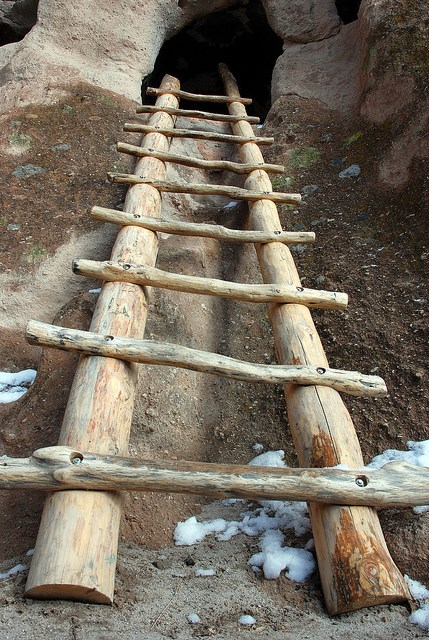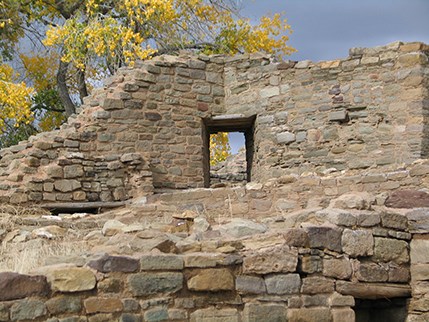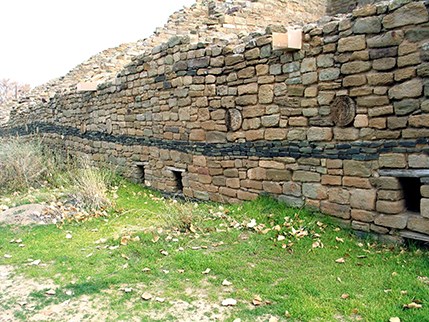Last updated: April 12, 2018
Article
A New Perspective

NPS photo by Sally King
On my drive out west toward Grand Canyon this year, I had the chance to stop at a few Ancestral Puebloan sites – namely, Bandelier, Chaco Culture, and Aztec Ruins. Having worked and spent some time around these types of sites before, I felt like I was seeing and appreciating these special places on a much deeper level than even I realized was possible.
My first stop was Bandelier. I didn’t have much time here, but I did manage to walk the main trail. What amazed me most about Bandelier was the innovation in using the softer rock to their advantage. I loved seeing an alcove carved out of the rock and used as shelter. This was especially cool when we could see rocks built into that hole to create a more “normal” size doorway, or extra rooms built in front of the small alcove rooms. And this soft rock made it especially easy to see and imagine it as it once was! At Long House, the pueblo no longer stands 3 stories, but I could clearly see the floors and sometimes even rooms that would have expanded outward from the rock! I like to close my eyes and imagine myself in the past, but this made it impossible to look away – I kept staring and could almost build the walls and roofs out simply by looking!
And what a difference a few miles can make! Chaco was remarkable in its own way. The intricate stonework was definitely a sight to behold – I don’t think many of us today would be patient enough to quarry that much stone! The great kivas were insanely technical and impressive to see, and I definitely gawked at the size of the kivas. To see them in a larger scale was unbelievable. And the pueblos themselves!! To line up the edges of Pueblo Bonito and Chetro Ketl with the sun rising and setting on one specific day of the year would take a tremendous amount of time and patience. I was almost baffled by the thought of the work it would take to create these great houses.

In a few rooms, the original plaster was even still on the rocks – I really liked seeing that too. We so often see these places as the remains of what they once were, and it was fantastic to have that reminder that they didn’t look even close to what we are currently seeing – there was not only plaster but often paint on top of that plaster (some of which was protected at Chaco, and definitely worth seeing!!). It was a great reminder for me, and made me once again realize how important these archaeological sites are – some places may be better preserved than what we can see now, and who knows what new information we might uncover in the future!
On a whim, I had decided to swing up to Aztec Ruins as well. I am definitely glad I did! I think I had almost saved the best for last. The fact that they had a reconstructed great kiva was absolutely amazing. It’s one thing to see the remains of what once was, but to see how it may have looked over 800 years ago was breathtaking. I found myself unable to speak above a whisper, being transported back in time. I could hear the conversations and the music, and all the activity that must have occurred here. It was almost a shock to see someone in modern clothes enter the kiva shortly after that – I had almost forgotten what year it was!!

The final thing that struck me about Aztec Ruins was the green stripe of rock imbedded in the pueblo. The ranger told me that the rock was not native to the area, so for some reason they decided to bring in these thin layers of rock, and make them part of the pueblo. It does make me wonder why the Puebloans decided to put that in. Was it just for decoration? Or was there a deeper purpose behind it? Perhaps some mysteries will never be solved…
Even having been to all these sites, I still feel like there is so much to learn. One thing is for certain – the people who lived at the Tusayan pueblo were just a small part of a much grander culture, one that impresses me in all they have been able to accomplish – not only in the architecture, but in every aspect of their culture. After all, the Puebloans have been living in the desert for over 1000 years – I wonder what we could learn if more people decided to listen?
– Originally published April 2015 in the Spring 2015 issue of No Name News.
